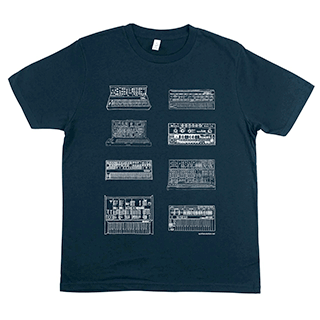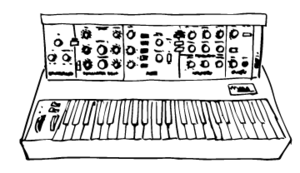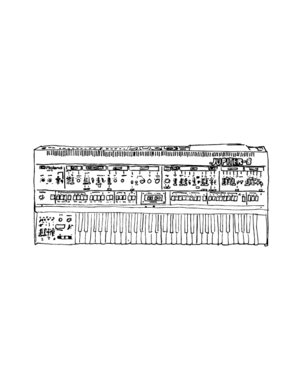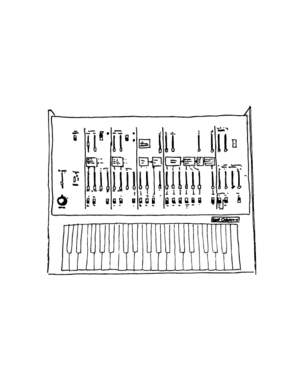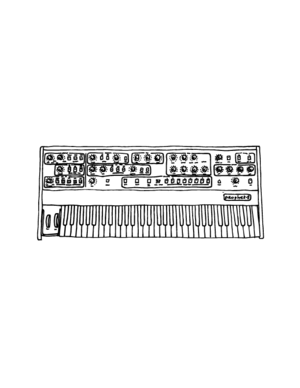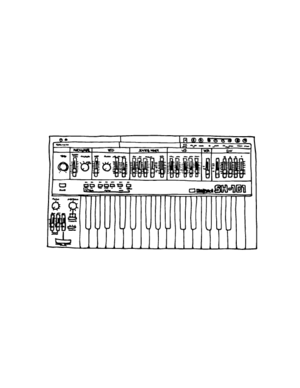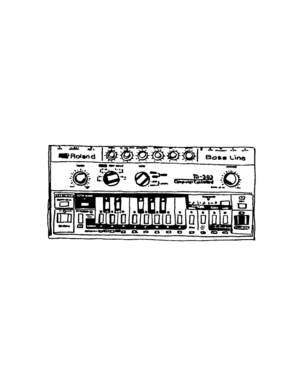Moog Minimoog Model D
v
Roland TB-303
The finals saw the meeting of two quite different monosynths. On the one hand was the solid favourite - the Minimoog. Launched in 1970 it was immediately hailed as a breakthrough synthesizer. Most synths prior were huge modular beasts the size of cabinets. The Minimoog minituarised these into a form factor that sounded just as good, but was portable and much more reliable. It’s been a classic for over fifty years and helped popularise synthesizers and electronic music over the course of the 1970s.
By contrast, the Roland TB-303 arrived at a time when the monosynth was a standard instrument in bands, and good polysynths were also becoming more widely available. Launched in 1981, the now familiar legend of the 303 played out: it was a flop at launch, only to be picked up cheaply by Chicago house music producers. The track ‘Acid Tracks’ by Phuture was then released in 1987 to change the face of dance music forever.
The battle then was between a solid synthesizer that could slot into all kinds of electronic music, from funk, pop, rock, avant-garde and pure electronic music, and one that could really only do one thing - but was a thing that no other synth can truly do, and was responsible for one of the most significant music revolutions of the late 20th century.
In the end it was the 303, the acid-house instigator, that took the crown. Not a result that I think many would have predicted at the start of the championships, but is certainly the result we have, and one that will continue to provoke debate for some time to come!
The final poll and result on Twitter: https://twitter.com/weare1of100/status/1370303071969017856
The story of the Synth World Cup
Thirty two synths started the competition on Monday - all the expected heavy hitters were there - the Minimoog, the Prophet 5, the CS-80, the Jupiter 8, alongside some quirky left-of-centre entries to ensure balance and fairness - the Octave Cat, the Oscar, the Crumar Bit One (!) amongst them.
Round 1 soon saw the sorting of the wheat from the chaff - going through were the ARP Odyssey, Minimoog, DX7, Juno 106, Jupiter 8, ARP 2600, Korg MS-20, Synclavier, D-50, Prophet 5, SH-101, M1, Moog Modular, TB-303 and Fairlight CMI. No real surprises there - classics all, with their places assured in history regardless. Admittedly, this was at the cost of some that might have been expected to get through - no CS-80, despite Vangelis’ best efforts on Bladerunner in 1981.
There was little love for those revolutionary analogue-modelling synths of the 1990s, the Access Virus and Novation Supernova. At the time these were a revelation of polyphony, sound and reliability. But not so fashionable now, clearly. Perhaps they didn’t have enough of an ‘identity sound’ to fall in love with or the unpredictable ‘charm’ of real analogue.
Bye-bye also to most of the quirky mono synths - OSCar, EMS VCS-3, Octave Cat, Korg Mono/Poly. So far, nothing too shocking! (Though I was sad not to see the Buchla Music Easel get through, representing as it does a more experimental approach to electronic music making).
Round 2 got a bit more serious and proved that analogue will always beat digital for a place in people’s hearts. The DX7, for all its digital shimmer and impact on launch in 1983, couldn’t hold a candle to the Minimoog. The D-50 - the DX7’s digital successor in 1987 - lost decisively to the comparatively poorly specified SH-101. The Prophet 5 easily dispatched the later digital workstation Korg M1 with two thirds of the vote.
And the Jupiter 8 made short work of the Synclavier. (Yes - the Synclavier did help kick start the sampling revolution, but it was ridonkulously expensive and out of reach of normal people. One 16MB card, for example, would cost you £15k!). The other super-expensive early sampler, the Fairlight CMI, lost decisively against the Moog Modular.
Match 3 between the Juno 106 and the ARP Odyssey was harder to predict, and I personally thought that the warm analogue polyphony of the Juno would see off the more limited Odyssey. But I was wrong - there’s clearly a lot of love for the Odyssey out there! Korg MS-20 vs ARP 2600 was quite close - 43% vs 57% to the ARP in the end; both very capable semi-modular synths, separated by a decade; the unruly model 2600 getting more appreciation in the end. And finally the TB-303 said goodbye to the EMS VCS-3 - farewell plucky UK semi-modular!
Quarter Finals
It was now time to make some hard choices with some definite ‘matches of death’. By co-incidence there were two matches featuring two synths from the very same company. So ARP fans had to choose between the 2600 - voice of R2D2! - and the Odyssey - a great little monosynth which has featured on many a great track (Stevie Wonder’s, ‘In the City’; Herbie Hancock’s ‘Chameleon’, amongst them). But it went quite decisively in favour of the Odyssey - 65% to 35%. Again - I think this was a bit of an upset! The 2600 was a legendary semi-modular that went through three iterations - the ‘blue marvin’ amongst them. Despite The Edge using one to get his legendary guitar tone with it’s filters and onboard spring reverb, it just wasn’t enough!
Similarly, Roland fans had to choose between the TB-303 and SH-101 - and yep, the 303 got its way with a similar margin of success. The other two quarter finals saw Moog dominate. The Minimoog and Jupiter 8 couldn’t have been closer - it was 51% to 49% in the Minimoog’s favour. A hard - ney, impossible - choice to be sure. By amazing co-incidence, the fourth quarter final also saw a Moog monosynth (the modular) up against another classic early 80s polysynth - this time the Sequential Circuits Prophet 5. Again the mono beat the poly - and the Modular went through fairly comfortably - 54% to 46%.
Semi-Finals
After the heart-wrenching decisions of the previous days voting, the semi-finals were real crunch time: two Moogs against each other - the original Moog Modulars vs the later simplified hardwired Minimoog. It had to be the Minimoog really, and indeed it was, with a winning margin of 20%. In the second semi-final, the ARP Odyssey’s luck had run out - and it was fairly decisively crushed by the TB-303 - 71% to 29%. To be honest, I think the Odyssey had a bit of lucky route through the World Cup - I’m not sure it should really have come ahead of those great poly synths, the Jupiter 8 and the Prophet 5 in the quarters for a start! But that’s the fun of a World Cup and the hard choices we have to live with!
THE FINALS
Two monosynths pitted against each other. Who would have predicted that? One is responsible for 30 years of genre-busting dance music, and the other was instrumental (pun intended?) in convincing the world that synths were real musical instruments and had a place in popular music as well as in the emerging electronic music scenes.
In the end, the world’s love affair with acid-house and respect for the machine that drove won the day! Well done Roland TB-303!
My favourite Tweet from the competition was the one below from Hardfloor - I wonder which way they voted?!


